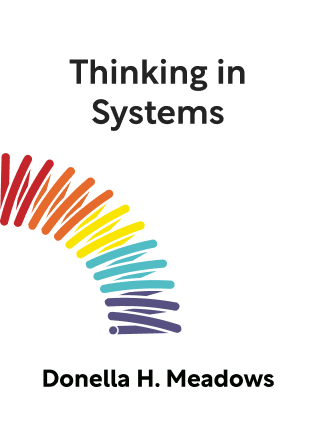

This article is an excerpt from the Shortform summary of "Thinking in Systems" by Donella H. Meadows. Shortform has the world's best summaries of books you should be reading.
Like this article? Sign up for a free trial here .
How can you improve your strategic systems thinking? Can you become a better systems thinker?
Strategic systems thinking can help you reframe your perspective on how things work. You can work on becoming a strategic systems thinker in order to better manage companies and all other kinds of structures.
Read more about strategic systems thinking and how to include your skills.
Improving at Strategic Systems Thinking
Learning to think in systems is a lifelong process. The world is so endlessly complex that there is always something new to learn. Once you think you have a good handle on a system, it behaves in ways that surprise you and require you to revise your model.
And even if you understand a system well and believe you know what should be changed, actually implementing the change is a whole other challenge.
The author ends with advice that she and other systems thinkers have learned over their lifetimes. (Shortform note: We’ve organized her points into three sections:
- Understanding systems
- Intervening in systems
- Systems in society)
Intervening in Systems
For many systems thinkers, the goal of understanding a system is to fix a problem or make it work better. But even if you understand a system and believe you know the best intervention for it, actually implementing that change is another, possibly greater, challenge. Here’s how you can work on your strategic systems thinking skills.
Question the Intervention to the Deepest Layers
When probing a system and investigating why interventions don’t work, you may bring up deep questions of human existence.
For example, you might think, “If these boneheads were only to open their eyes and accept this data, then they’d see the value of the solution, and we could fix the system.” But this raises deeper questions: How does anyone process the data they receive? How do people view the same information through different cognitive filters? Why can the same data lead to two completely different conclusions from two different people?
Likewise, you may think a system needs to reorient its values. But where do values come from? Why does someone arrive at the values they have? Why does it seem easier to orient around quantitative values than qualitative ones?
Social systems are driven by deep human needs and emotions, and that’s why they can be so resistant to change. This complexity can be maddening, but understanding it is necessary to appreciating why systems fail and how to improve them.
Empower the System to Do More Internally
As an intervenor, resist the tendency to bring in outside solutions that cripple the system’s ability to take care of itself (this is the system trap of addiction). Instead, try to empower the system to do more internally, to solve its own problems.
For instance, to nurture a developing economy, don’t bring in foreign corporations to build factories to “create jobs.” A more internally-empowering solution would be to issue small loans to local entrepreneurs and teach business skills.
Tighten Feedback Loops on Responsibility
Actors in a system can behave poorly when they evade accountability for their actions. Tighten the feedback loop between the actor and the consequences of its behavior. Examples include:
- Limit health insurance payouts to car drivers who don’t wear seatbelts.
- Prohibit Congress from legislating laws that it gives itself immunity from.
- Require decision-makers who start a war to participate in the war.
Make Interventions Dynamic and Nonlinear
Intervenors can issue rules, laws, and policies to influence systems. These policies are often static—change this parameter in perpetuity, regardless of what changes in the world.
However, systems behave dynamically, and a fixed policy that was appropriate at one stage of its development may be inappropriate in another. Instead, consider dynamic, flexible policies that can operate nonlinearly over a range of conditions, and that is open to changing over time.
For example, consider a law to reduce a new pollutant, based on preliminary, uncertain data that the pollutant is harmful. Instead of a static policy of a fixed tax, consider a dynamic policy:
- For a single polluter, the tax scales up as the polluter generates more pollution.
- System-wide, the tax scales up as pollutant levels increase.
- The data should be monitored, and the policy revisited in 3-year intervals in case the interpretation changes.
With a dynamic policy like this, the policy can continue to achieve its goal even if if the situation turns out to be better or worse than currently understood.
Strategic Systems Thinking Exercises
These exercises can help you improve with your strategic systems thinking.
Exercise: Define a System
Pick a system that you want to understand better. If you can’t think of one, here are suggestions: your employer; your favorite store; your political party; an organism.
What are the major elements of the system?
What are the key interconnections between these elements? Think about physical interconnections, as well as intangible ones based on transferring information.
What are the major purposes of the system? Remember, look at what the system actually does, not what its stated purpose is.
Exercise: Feedback Loops
Think about everyday systems and how feedback loops affect them.
Can you think of any decision you make where a feedback loop is not involved? What is it?
Think harder—in what way does what you’re deciding about influence what you decide?
Think of a recent time where you blamed a problem on something. Phrase it as “A caused B.” (Try not to think about a single person making a mistake, but rather about a system-level problem, such as a political or societal issue.)
Now invert the situation. Is it possible that B caused A? How could this be true?
Exercise: Improve Your System
Think about how to improve your system with the three main reasons they perform well.
What’s a system you care about? If you need ideas, consider your employer, a group you belong to, yourself as an individual, or a physical system.
Is this system resilient? What is the range of conditions in which the system can perform naturally? How can you improve the system’s resilience?
Is the system capable of self-organization? Does it freely allow experiments that allow it to adapt? How could you improve its self-organization?
Does the system have a capable hierarchy? Can the subsystems work independently with minimal communication with other systems? Does the larger system function to support the subsystems in pursuit of a larger goal? How can you improve the hierarchy?

———End of Preview———
Like what you just read? Read the rest of the world's best summary of Donella H. Meadows's "Thinking in Systems" at Shortform .
Here's what you'll find in our full Thinking in Systems summary :
- How the world, from bathtub faucets to fish populations, can be seen as simple systems
- The key system traps that hold back progress, such as escalating arms races and policy addiction
- Why seeing the world as systems can give you superpowers in work and life






